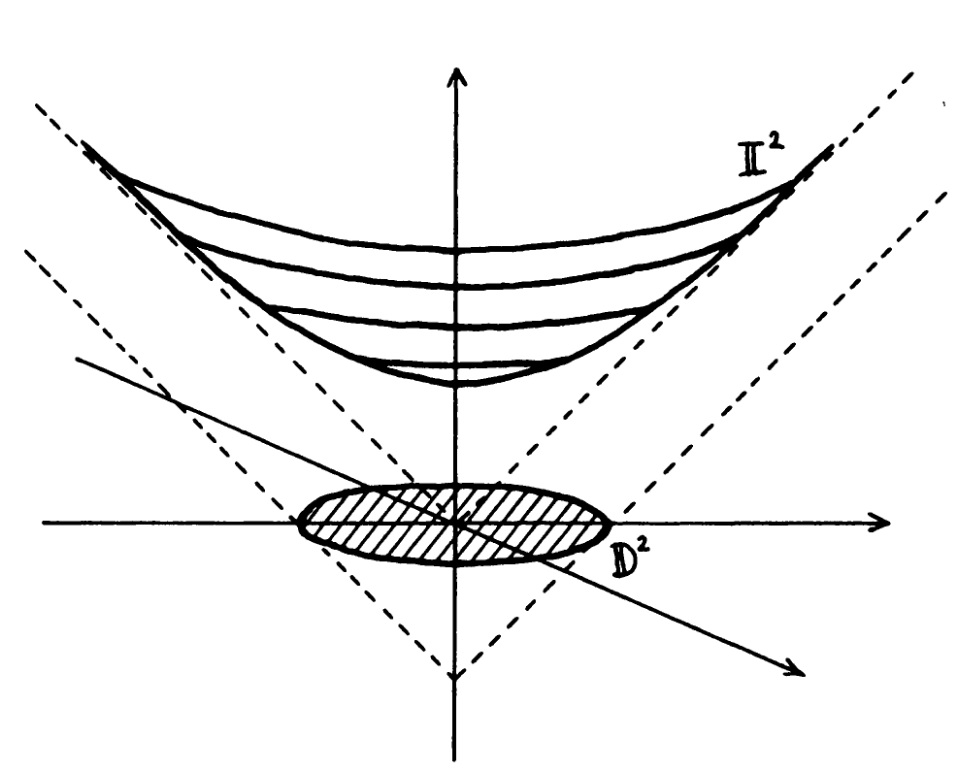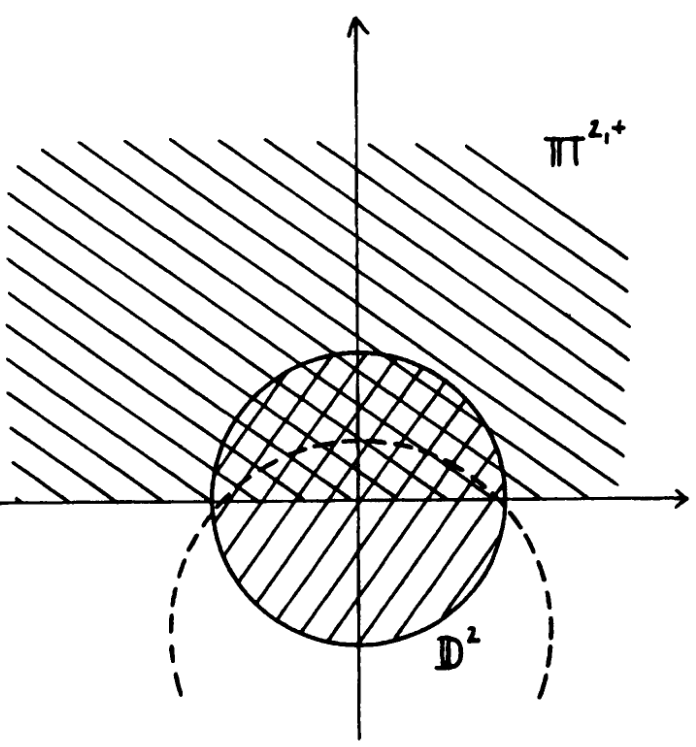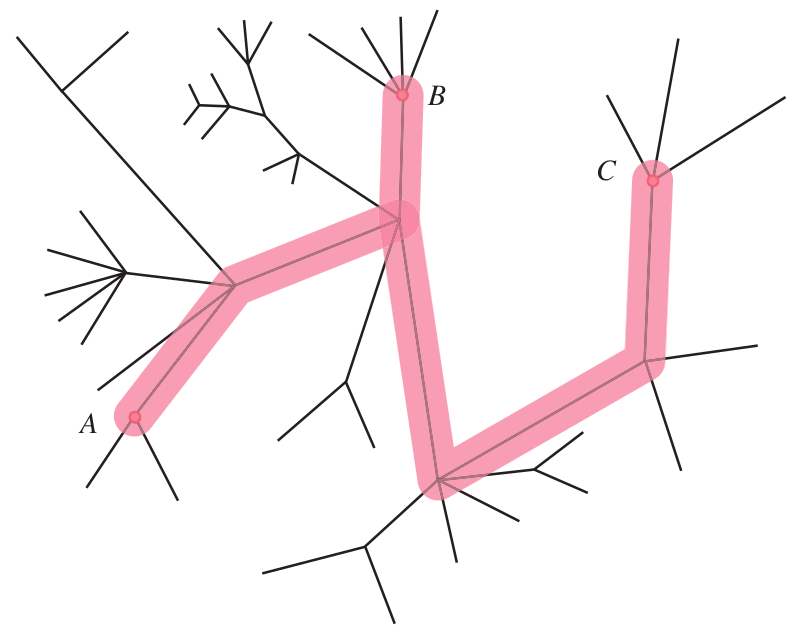is a smooth -manifold with tangent space:
Since , the restriction of to is positive-definite.
Then it is a scalar product on and hence gives a metric struture.
We shall denote by the manifold endowed with this metric structure.
Disk Model
Disk model comes from steographic projection of .
Dash lines indicate boundary of this projection.

Half-Plane Model
Half-space model comes from a Möbius transformation of .
It is a geometric inversion explained in the left picture: .


Isometry of
We admit following non-trival proposition
A sufficient condition for a diffeomorphism of to preserve lengths is that it preserves angles.
We remark that
- it is trivial that length preserving implies angle preseving
- Möbius transformation is conformal, hence maps geodesics to geodesics in hyperbolic space
- this proposition is powerful and streamlines proofs in elementary hyperbolic geometry.
Now we land back to and claim:
In disk model and half-plane model , geodesics are orthocircles, which are lines/circles perpendicular to the boundary.
Because half-plane is conformal to disk model , we only need to prove this for disk model .
- Diameters are fixed set of reflections hence are geodesics, they are perpendicular to boundary.
- Diameters are all geodesics passing the origin by uniquess of geodesics.
- After Möbius transformations that fix we get all orthocircles from diameters.
Here we play a game to illustrate geodesics in disk model :
Spaceship in disk model .
Use Mathematica to interact with triangles in disk model .
-Hyperbolicity
-hyperbolicity is a property shared by geometrical trees and hyperbolic plane:
Triangles are thin.
A triangle is -thin if each side is in the -neighborhood of other two sides.
In the definition of -hyperbolicity, the actual value is not important.
But we remark:
- In geometric trees, , since .

- What should the actual value of of hyperbolic plane?
We can calculate this if we have time at the end.
Hyperbolic group
We claim without detailed verfication that:
-hyperbolicity is invariant under quasi-isometry.
We apply this to get a definition:
- A finitely generated group is called hyperbolic if any of its Cayley graphs (for a finite generating set) is -hyperbolicity.
- Well-defined since different finite generators give quasi-isometric Cayley graphs
Surface groups are hyperbolic
Surface groups are defined to be fundamental groups of hyperbolic surfaces.
- To define a hyperbolic surfaces / mainfold, we need to work with charts.
- This claim says that
Hyperbolic surface has a hyperbolic fundamental group.
Add extra structure to manifold
A mainfold has chart in with smooth coordinate transformation.
To generalize, we
- allow charts to locate at a space form
- restrict coordinate transformation to be restriction of orientation-preserving isometry group .
- This defines a -manifold.
Example: torus is flat
We call an -manifold is
- hyperbolic, if
- elliptic, if
- flat, if
We shall classify all surfaces soon.
Quotient manifold and Švarc–Milnor lemma
- A -manifold as Riemmanian manifold
- is quasi-isometric to
- It follows
Hyperbolic surface has a hyperbolic fundamental group.
- We then want to find out hyperbolic surfaces, that is to say,
a geometric classification of surfaces.
Geometric classification of surfaces
We always assume closed, oriented and connected surface / -manifold.
Elliptic surface
-Sphere is the only elliptic surface since every element of has fixed points, which forces elliptic surfaces as quotient manifold of to be trivial.
Flat surface
We have shown torus in Mathematica
Hyperbolic surface
Surface with genus bigger than 2, i.e., connected sum of -torus (with ) are hyperbolic.
Prove by JavaScipt Code.
Bonus (if we have time)
-
Actual value of of hyperbolic plane is .
- In disk model, move triangle to contain the origin then vertices are on radius, endpoints of three radius form an ideal triangle containing the original triangle.
- Any ideal triangle is enough to conclude since Möbius transformation is 3-transitive.
- We only need to cover one side of ideal triangle by the same reason above, to simplify put it in half plane model.
- Finally our problem reduces to finding distance of a midle-point to another side. Use reflection.
-
A snake game on -torus
Appendix and notes (out of presentation)
Formal definition of -structure
Let be a connected, simply connected, oriented -dimensional manifold(), and let be a group of diffeomorphisms of onto itself; we shall say a differentiable -manifold is endowed with an -structure if we are given an open covering of and a set of differentiable open mappings (with ) such that
- is a diffeomorphism;
- if then the restriction of to each connected component of is the restriction of an element of .
will be called an atlas defining the -structure.
Classfication using complex analysis
This classfication corresponds to uniformization theorem about simply connected Riemannian surfaces.
- Any surface has isothermal coordinate.
- Isothermal coordinate gives a complex structure on this surface.
- Universal covering of a Riemannian surface is a simply connected Riemannian surface.
- There are only three possible simply connected Riemannian surfaces: , and .
- These three possibilities correspond to elliptic, flat and hyperbolic surfaces.
- Details are in Dynamics in One Complex variable, chapter 1, section 2, third edition by John Milnor.
Notes
- Uniquess of geometric classification comes from Gauss-Bonet theorem and trianglization of surfaces.
- Another proof of hyperbolic surfaces uses pant decomposition of -torus (with ). See Reimannian Geometry, section 3.L.4 compact surfaces, third edition, by Sylvestre Gallot, Dominique Hulin and Jacques Lafontaine.